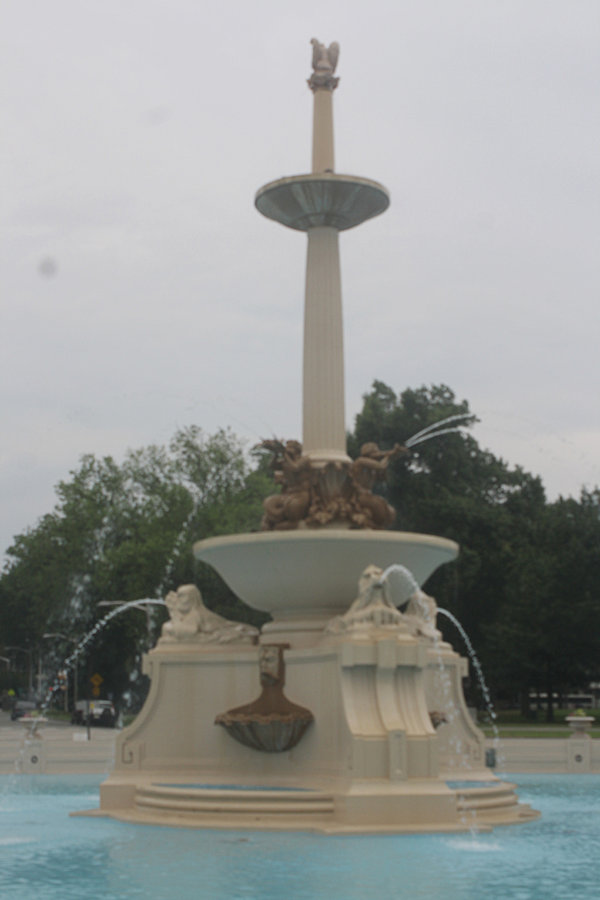For more than five years, the Hudson County Board of Freeholders has struggled to get the right combination of architect, contractor, and grant money in place to allow the Lincoln Park Fountain to be restored.
Each year, the cost of the project rose, partly because of unexpected problems and delays. But in June, a fountain that first opened more than a century ago was rededicated, using technology as contemporary today as the technology that went into the fountain when it was first constructed in 1911.
The Lincoln Park Fountain is located at the gateway to Lincoln Park off of West Side Avenue in Jersey City.
Although efforts were made to maintain the fountain over the last century, the most recent effort is only the second major restoration since it first opened on Aug. 24, 1911 in what was then known as “West Side Park.”
The original cost to construct the fountain was $6,500. The current restoration of the fountain cost about $7.2 million.
“It is another great investment by the county along with the golf course, new running track and many others that makes the park a gem of a park that helps encourage people to move into and stay in the West Side area,” said Freeholder Bill O’Dea.
Caring for historic sites
County Executive Tom DeGise said the fountain had been neglected for decades, and that it was important for the county to preserve a piece of Hudson County history.
“This will stand for another 75 years.” – Tom DeGise
____________
He said past efforts to restore the fountain had been makeshift at best.
“If we planned to fix this, we had to get into the infrastructure,” he said. “It was a lot of time and money, but gauging from the reaction we got, the public is very grateful for it. This will stand for another 75 years.”
One possible cause for deterioration of the original found was traffic that previously used the park as a short cut from West Side Avenue to Route 440. Originally the fountain made up the center of a traffic circle in the park. But county officials have redirected traffic away from the fountain.
“We can’t let historic things like this crumble or they won’t be there in future,” DeGise said.
The fountain is an icon of Jersey City.
“You can show a picture of it to someone who has moved out of Jersey City and they will know exactly where and what it is,” DeGise said.
New innovations for restoration
The restoration work conducted by Nicholson & Galloway General Contracting of Glenn Head, New York, was awarded through a competitive bidding process approved by the Board of Freeholders. Helena Ruman, AIA, was the Hudson County Restoration Architect of Record for the project.
“This is an amazing project,” said O’Dea, who has been in the forefront of getting the restoration done. “This is something special in the county’s oldest park.”
Constructed of reinforced concrete, designed by Pierre J. Cheron of New York to fit in with the historic surroundings, the fountain at 53 feet high was considered the largest concrete fountain in the United States at the time, using what was then considered a revolutionary process for construction.
Although used for a number of purposes since Roman times and introduced into the Americas in the 16th century, concrete’s use for construction took a long time to get accepted in the United States. Even as late as the 1880s, it was largely considered a novelty. With the turn of the century, its use for construction of ornamental landscape architecture such as fountains became more acceptable, replacing natural stone.
The fountain is the center of Lincoln Park.
It included sculpted seashells and scrolls, dolphins, triton, gargoyle’s heads and an eagle. It was also encircled with water spouting frogs. These features used a wet cast method in which wet concrete was injected into plaster molds, and then later etched with acid, sandblasting or mechanical methods. In reconstructing these, contractors used 3D printing technology that helped shape the original features.
When first constructed, it had 27 water spouts and 150 electric lights for night time illumination.
A century of wear
But over the years, the structure and base has weathered and deteriorated,
Over the years, the fountain has undergone a number of repairs and restoration attempts including in 1973, and again in 1988. Disrepair was so significant in 1884 that the county shut off the water until 1988 when the basin concrete slab was replace and frog sculptures were repaired.
The most recent restoration was years in planning, and ran into significant funding and other setbacks. The county project was to stabilize, preserve, and restore the fountain structure and replace the basin, including the mechanical and electrical systems.
Unlike previous efforts, the latest restoration included replacing of the entire plumbing system, using noncorrosive materials, as well as a new water recirculation and filtration system.
The new restoration also replaced the basin’s concrete floor and walls with reinforced concrete. The various water features include fiberglass reinforced concrete. Each element is an exact duplicate of the original.
“You have to see this fountain lit up at night,” O’Dea said. “It is something spectacular to see when you look down at it from West Side Avenue.”
Al Sullivan may be reached at asullivan@hudsonreporter.com.
